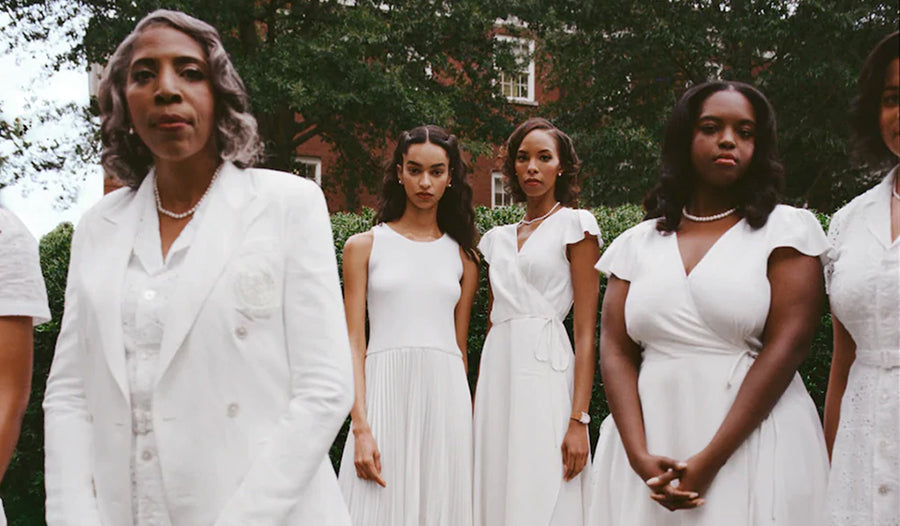
RALPH LAUREN AND THE AMERICAN DREAM
Excerpt from the article Ralph Lauren revises his vision of the American Dream, inspired by the style of HBCUs, written by Robin Givhan and publihsed on The Washington post online. Read the full article here.
 Image: From left, Thea Johnson, from the Spelman Class of 1984; model Franciele Santos; Kasmere Trice, from the Class of 2015; and Joyya Baines, from the Class of 2013, pose in looks from the new Ralph Lauren collection. (Ralph Lauren)
Image: From left, Thea Johnson, from the Spelman Class of 1984; model Franciele Santos; Kasmere Trice, from the Class of 2015; and Joyya Baines, from the Class of 2013, pose in looks from the new Ralph Lauren collection. (Ralph Lauren)
It’s not a new story. It’s a more complicated, more nuanced version of an old one. So ultimately, it’s a better story.
The clothes debuting Tuesday in a Polo Ralph Lauren advertising campaign — the tweed soft-shoulder blazers, the Fair Isle sweaters, the pretty white eyelet dresses and one perfectly aged cotton canvas stadium coat — are familiar to anyone who has been schooled in the narrative of the American Dream, which is to say, most everyone. They aren’t the sort of clothes that nudge fashion trends into uncharted territory, and they aren’t flashy exemplars of financial success. Like all garments, they’re an expression of identity. But these are, most importantly, an enduring declaration of belonging.
This country doesn’t have anything that might be called a national costume, but certain garments help folks visualize what it means to be that self-invented notion: an American. It’s a challenging persona to fathom. Despite popular culture equating it with blond and blue-eyed, Americans aren’t defined by race or ethnicity. They aren’t defined by their family tree. But still, we stubbornly try to cast an American ideal in human form — an embodiment of all our conceptions about our national character, which include the glories of bootstrap advancement, the power of clear-eyed optimism and a soft-focus romanticization of our rebellious past.

Image: RJ Jackson, a Morehouse student from the Class of 2025, poses in attire from the new Ralph Lauren collection. (Ralph Lauren)
No other designer has been more central to helping us paint a picture of those yearnings and aspirations than Ralph Lauren. Since he founded his company in 1967 based on a single product that encompassed both tradition and possibility — a tie that was slightly wider than the norm — he has been creating clothes that are deeply rooted in the idea of heritage even as they aim to put a bright, shiny polish on contemporary times. He has been inspired by the beautifully dilapidated country cottages of the Atlantic Coast and the wide-open spaces of the West, as well as Wall Street gods, country club scions and big men on campus.
For more than 50 years, Lauren has been writing a tale about what it means to be American. And now he’s made a significant edit. It isn’t so much a correction as it is a clarification.
Video: A Ralph Lauren ad campaign highlights the brand's partnership with HBCUs. (Video: Courtesy Ralph Lauren, Photo: Courtesy Ralph Lauren)
His new advertising campaign, which includes photographs, picture books and a 30-minute film, announces a partnership with Morehouse College and Spelman College, two institutions rich in both tradition and prestige. They are two of the historically Black colleges and universities that educated Black students during segregation and continue to do so today as predominantly White institutions typically treat Black history as a niche subject to be discussed in the safety of a singular department rather than a discipline intrinsic to the American story. The story of Blackness is a part of our collective history that can cause discomfort and because of that is especially under assault these days.
 Image: Spelman student Mykel-Michele Longino, from the Class of 2022, left, with models Franciele Santos and Aaliyah Hydes. (Ralph Lauren)
Image: Spelman student Mykel-Michele Longino, from the Class of 2022, left, with models Franciele Santos and Aaliyah Hydes. (Ralph Lauren)
The clothes in this licensing agreement with the two schools were mostly photographed on students, graduates and faculty — against the backdrop of the two campuses, which neighbor each other in Atlanta. The collection was inspired by images from the schools’ archives of students dating back to the 1920s as they gathered on the yard, in a classroom or on the playing field. Composed of some 100 items, the collection includes the crested jackets favored by Morehouse men, the signature Spelman white cotton attire — which remains a tradition, along with pearls — and the varsity jackets and crew neck sweaters that are staples of the broad college vernacular. It would be tempting to call these looks Ivy League style. But that’s only because those who had the power to codify elements of American achievement didn’t account for Black students. Princeton and Harvard preceded Morehouse in existence, but what was worn on the campuses up North in the 1950s, when they became defined by sack suits, Oxford shirts and rep-stripe ties, was also worn on the campus of Morehouse, which was founded in 1867.
Lauren has shifted his gaze to take in a new vista that has been there all along but one that he simply didn’t see. Until, one day in 2020, he suddenly did...
Excerpt written by Robin Givhan and published originally on The Washington Post.
Read the rest of the article in its entirety on The Washington Post website: Ralph Lauren revises his vision of the American Dream, inspired by the style of HBCUs
